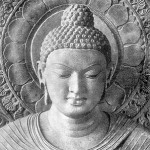
Dave Mermelstein presented this teaching in November 2015
The Five Skandhas: Heaps? Aggregates? How about “Rivers of experience?”
The skandhas can be thought of as the components that come together to make an individual, a sense of self, an “I” or “me”.
Everything that we think of as “I” is a function of the skandhas. Put another way, we might think of an individual as a process of the skandhas.
The component parts of the skandhas work together so seamlessly that they create the sense of a single self, or an “I.” But the Buddha taught that there is no “self” occupying the skandhas. Understanding the skandhas is helpful to seeing through the illusion of self.
They are:
- Form or matter/ something that can be sensed
- Feeling / Sensation
- Perception/ recognition
- Mental formations/ thought/ volition/ free will
- Consciousness/ awareness
- Form – or matter; something material that can be sensed.
The Five Sense Organs & The Five Corresponding objects:
- Eye Visible Forms
- Ear Sounds
- Nose Smells [chemical compounds]
- Tongue Tastes
- Body Tangible things [touch, inner-body]
Additionally, we should include the inner-body feelings of hunger and thirst, and feeling satiated or having our thirst quenched. Furthermore, we should consider the feelings of being ill, and of being deeply relaxed.
- Feeling or Sensation- Vedana–is the physical or mental sensation that we experience through contact of the six faculties with the external world. It is the sensation experienced through the contact of eye with visible form, ear with sound, nose with odor, tongue with taste, body with tangible things, and mind with ideas or thoughts.
Although this is called the skandha of feelings, it does not mean emotional feelings, but something more like sensations. These are said to be the painful, pleasant and neutral sensations in the body and the in the mind.
We are always experiencing sensations, mostly neutral ones, but also painful and pleasant. They can also be thought of as the sensations that occur based on sense impressions. A sense object such as incense would belong under the skandha of form, but the sensation created when we smell it belongs in this category of feelings. And this could be pleasant or unpleasant, depending on whether you like or dislike that incense.
According to the teachings, feelings are important because they are the basis for attachment and aversion.
- Perception – is the capacity to conceptualize and recognize things by associating them with other things. For example, we recognize shoes as shoes because we associate them with our previous experience with shoes.
It’s important to realize that this is not the bare perception of a thing, but the recognition of it. So, not the chemical process taking place on the tongue between the sodium atom and the taste receptor, but the recognition of that contact as “salty.”
Perception means the apprehension of a specific object, as distinct from something else. On the conceptual level, this means the recognition of identities or names, and on the sensory level it means the discernment of the five objects of sense. Technically, perception is defined as ‘that which grasps or identifies characteristics’. Perception could be non-conceptual, in the case ofthe five physical senses, or conceptual, as in the perception of thoughts and ideas.
- Mental Formations/ Objects of Mind– Thoughts and emotions. Volition, or will. Action, agency.
The category called Formations is a little complicated. But if we limit ourselves to mental formations, then it basically refers to thoughts and emotions, or what are technically referred to as the ‘mental states’. Biases and prejudices belong to this skandha, as do interests and attractions. Cultivated, meditative mind states such as calm, loving-kindness, equanimity, and compassion also fit within this skandha.
All volitional actions, good and bad, are included in the skandha of mental formations. But– how are actions “mental” formations? Our mental states cause us to act.
Remember the first lines of the Dhammapada:
We are what we think- all that we are arises with our thoughts… Speak or act with an impure mind and trouble will follow you… Speak or act with a pure mind and happiness will follow you…
The skandha of mental formations is associated with karma, because volitional acts create karma, just as mind states express intentions, which then lead to action. So emotional states cause us to act in certain ways, and those actions cause or affect our karma.
5. Consciousness/ awareness
Consciousness here refers to the awareness of impressions from the five senses, and also consciousness of mental objects, like thoughts, ideas and emotions. The consciousnesses of the five senses (seeing, hearing, smelling, tasting, and touching) are non-conceptual (“when hearing, there is only hearing”). This consciousness is where there is a receiving, a holding, of sense data. Visual consciousness registers only colors and shapes. It does not recognize particular colors, which is the function of the skandha of perception. Nor does it identify certain colors as pleasant, which is done by the skandha of feeling.
It is important to understand that consciousness depends on the other skandhas and does not exist independently from them. It is an awareness but not a recognition, as recognition is a function of the third skandha. This awareness is not sensation, which is the second skandha. For most of us, this is a different way to think about consciousness, since we usually think of it as the chugging along of our mental processes.
It is also important to remember that consciousness is not “special” or “above” the other skandhas. It is not the “self.” It is the action and interaction of all five skandhas that create the illusion of a permanent, separate self.
____________________________________
We can learn to see all of these as streams of experience, always occurring, that all together create our sense of self. So when we get familiar with these, we can, at any time, stop and ask ourselves: What is making this experience of Me right now? What streams of experience are happening right now, that make me feel this sense of “I”, of “me”?
And just as we say that we can stand on line at the grocery store and engage in mindful breathing meditation, or that we can stand in Mountain Pose while we are waiting at the bank, so too can we engage in the investigation of “what makes me feel that I am a separate self right now?” by exploring these elements of being, these skandhas, at any time.
It can become an active investigation, and we can know this teaching experientially, with our whole being.
Sources include: An Introduction to the Aggregates by Barbara O’Brien; About.com, Guide to the Five Skandhas; www.rigpawiki.org; and Guy Armstrong’s dharma talk on the subject, 10-02-15 at Spirit Rock Meditation Center.
Download the The Five Skandhas




